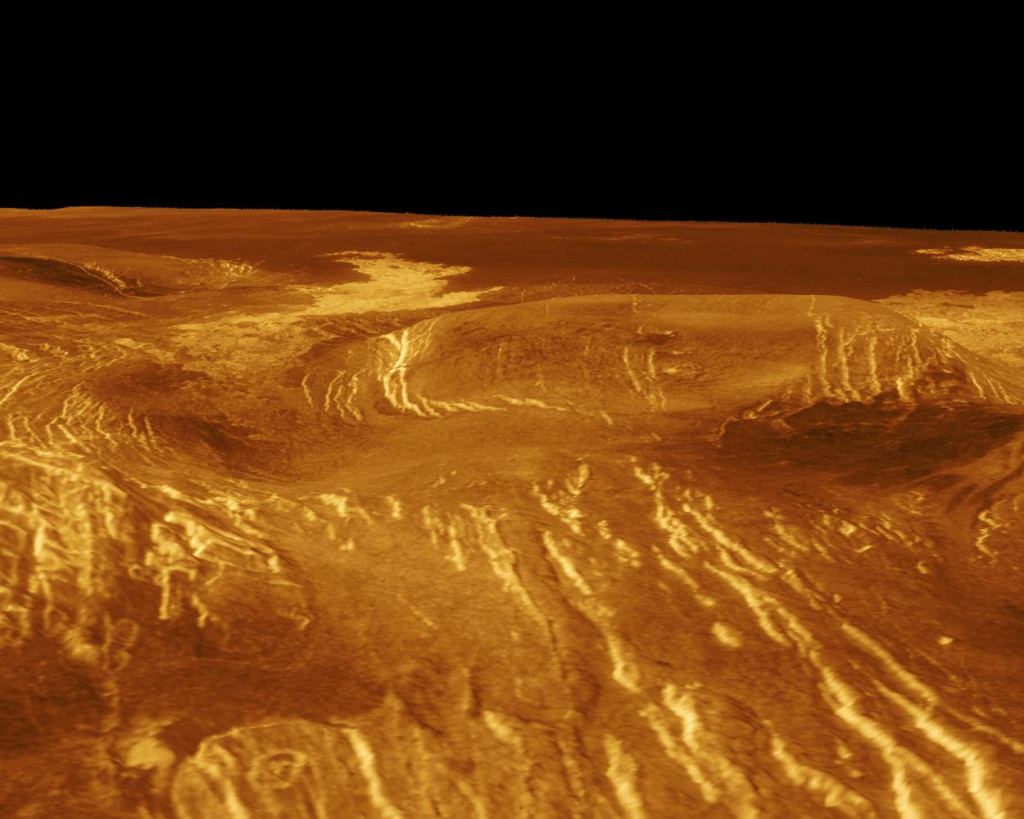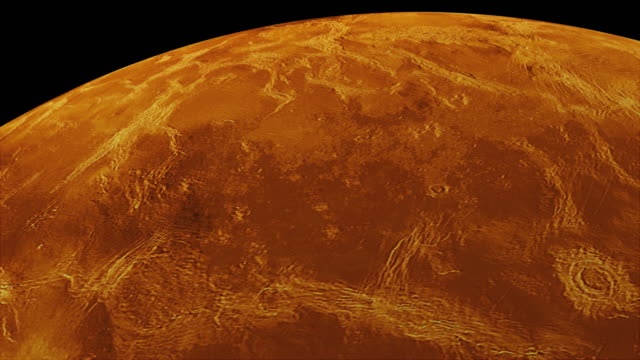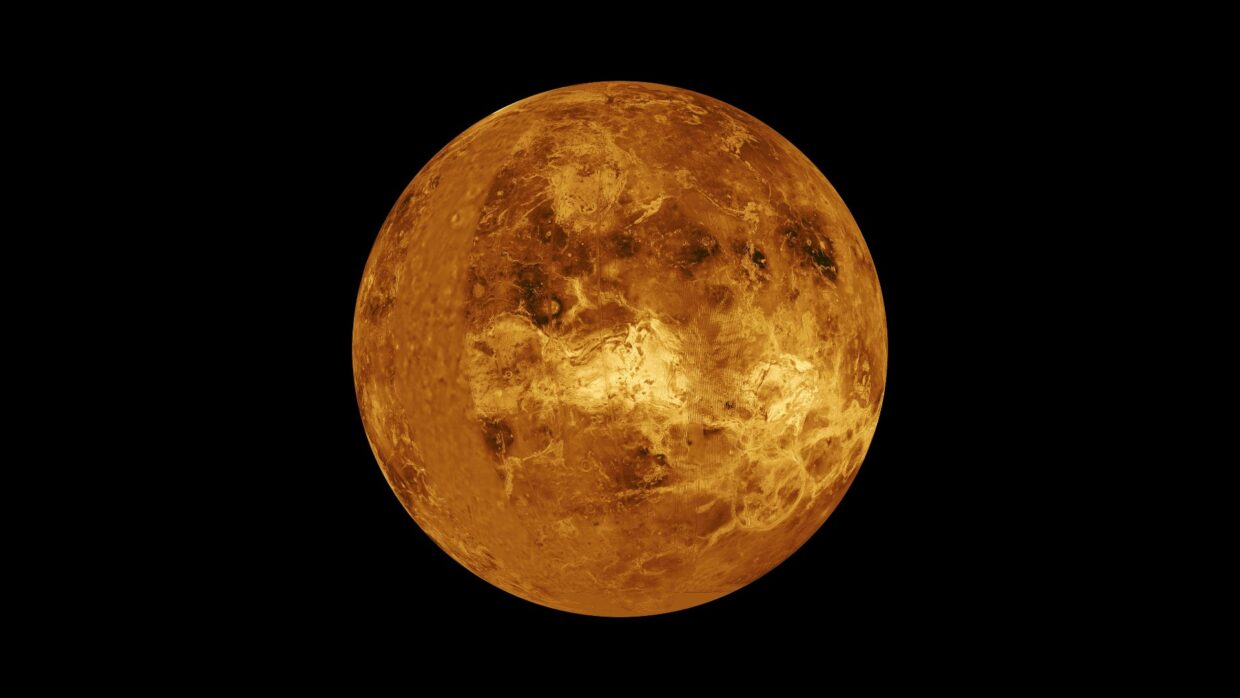Venus, the second planet from the Sun, is often referred to as Earth’s “sister planet” due to its similar size and composition. With a thick atmosphere primarily composed of carbon dioxide, Venus experiences a runaway greenhouse effect, making it the hottest planet in our solar system!
Orbital period: 225 days
Length of day: 243d 0h 0m
Distance from Sun: 108.2 million km
Gravity: 8.87 m/s²
Radius: 6,051.8 km
Surface area: 460.2 million km²
Mass: 4.867 × 10^24 kg (0.815 M⊕)
In certain aspects, Venus stands as more of an opposite to Earth than a twin: it spins backwards, a day surpassing its year in duration, and the absence of recognizable seasons. There is a possibility that Venus may have resembled an inhabitable ocean world akin to Earth over a billion years ago. However, a runaway greenhouse effect transformed all liquid surface water into vapor, subsequently dissipating into space. The current landscape is characterized by volcanic rock subjected to extreme temperatures and pressures. When questioned about the potential for Venus’ present surface to support life, a definitive response would be a resounding “no.”


How Venus Got Its Name
The ancient Romans could easily see seven bright objects in the sky: the Sun, the Moon, and the five brightest planets (Mercury, Venus, Mars, Jupiter, and Saturn). They named the objects after their most important gods. Venus, the third brightest object after the Sun and Moon, was named after the Roman goddess of love and beauty. It’s the only planet named after a female god.
Size and Distance
Venus orbits the Sun from an average distance of 108 million kilometers, or 0.72 astronomical units. One astronomical unit (abbreviated as AU), is the distance from the Sun to Earth. From this distance, it takes sunlight about six minutes to travel from the Sun to Venus.
Orbit and Rotation
Spending a day on Venus would be quite a disorienting experience – that is, if your spacecraft or spacesuit could protect you from temperatures in the range of 900 degrees Fahrenheit (475 Celsius). For one thing, your “day” would be 243 Earth days long – longer even than a Venus year (one trip around the Sun), which takes only 225 Earth days. For another, because of the planet’s extremely slow rotation, sunrise to sunset would take 117 Earth days. Additionally, the Sun would rise in the west and set in the east, because Venus spins backward compared to Earth.
Surface
Volcanoes and tectonic forces appear to have erased most traces of the early surface of Venus. Newer computer models indicate the resurfacing may have happened piecemeal over an extended period of time. The average age of surface features could be as young as 150 million years, with some older surfaces mixed in.
Venus boasts valleys and towering mountains adorned with numerous volcanoes. Its surface showcases distinctive features, with many named after both real and mythical women. Among these features are Ishtar Terra, a rocky highland expanse comparable in size to Australia, situated near the north pole. Another extensive region, Aphrodite Terra, rivals the size of South America and spans the equator. A prominent mountain on Venus soars to an impressive 36,000 feet (11 kilometers), surpassing the height of Mt. Everest. Noteworthy is the fact that, apart from Earth, Venus exhibits the fewest impact craters among all rocky planets.
Atmosphere
Venus’ atmosphere is one of extremes. With the hottest surface in the solar system, apart from the Sun itself, Venus is hotter even than the innermost planet, charbroiled Mercury. The atmosphere is mostly carbon dioxide – the same gas driving the greenhouse effect on Venus and Earth – with clouds composed of sulfuric acid. And at the surface, the hot, high-pressure carbon dioxide behaves in a corrosive fashion. But higher up in the atmosphere, temperatures and pressure begin to ease.
FUN FACTS!
- A day on Venus is longer than a year!
2. Venus is hotter than Mercury – despite being further away from the Sun!
3. Venus is the second brightest natural object in the night sky after the Moon!
4. Venus has 90 times the atmospheric pressure of Earth!
5. The atmosphere spins faster than the planet!
https://en.wikipedia.org/wiki/Venus
https://science.nasa.gov/venus/
https://science.nasa.gov/venus/facts/
https://www.rmg.co.uk/stories/topics/interesting-facts-about-venus
